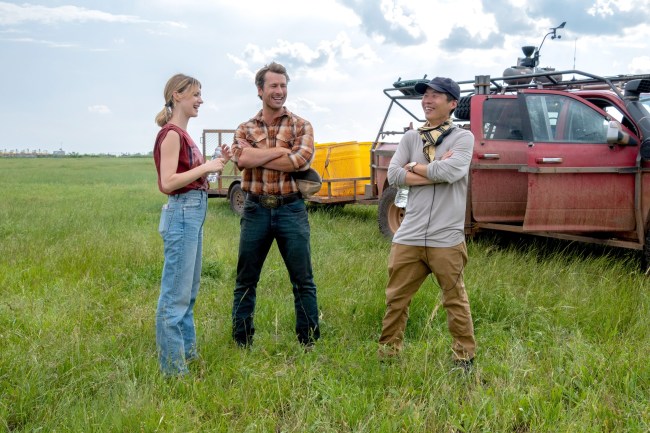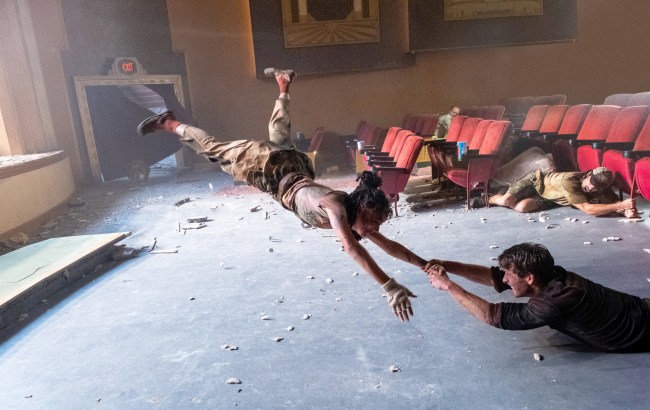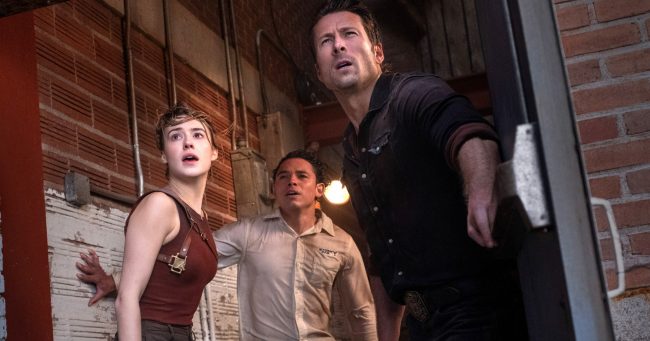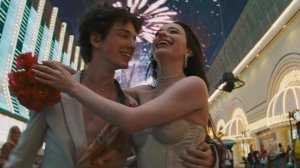After seeing an actual barn burn during the filming of “Minari,” Lee Isaac Chung knew he wanted to make a disaster movie.
The Oscar-nominated filmmaker behind this bittersweet, semi-autobiographical portrait of South Korean immigrant life in rural Arkansas is now the director of “Twisters” — not a reboot, not a sequel, but an expansion of the world built (and destroyed) by the 1996 tornado blockbuster. Here, a team of science-loving storm chasers led by Daisy Edgar-Jones and Anthony Ramos becomes rivals to a more plucky group of thriller seekers led by Glen Powell in this summer’s ultimate blockbuster — and his most compelling argument for the importance of big-screen experience.
But back to that burning barn that so intoxicated its director. In “Minari,” Jacob (Steven Yeun) watches as flames engulf his barn after his mother-in-law (Yuh-Jung Young) sets it on fire. Filming that moment was one Chung has pursued ever since, as doggedly as one of the storm chasers in “Twisters.” A hands-on approach to those effects, involving a controlled fire in the barn itself, inspired at least two of Chung’s staples entering the world of “Twister” IP: shooting on location in Oklahoma and balancing the practical effects with the CGI required for the $200 million sequel.
“I’m very hard on myself as a filmmaker,” Chung told IndieWire in a recent interview to discuss “Twisters,” his first feature film and second project after “Minari” after directing an episode of the Star Wars series “The Mandalorian.”
“When I worked on the Lucasfilm projects (including Skeleton Crew ), I felt like I had to learn something. Those shows are very effects-driven, so I learned to distinguish between what’s great and what makes me want to do it again. A lot of the time, the shots that really excited me were the ones that had the most practical effects,” he said. “The ultimate anchor for me was the shot I did in Minari where the barn goes up in flames, which was completely practical. It was way bigger than I had anticipated. And it just holds up because it’s real, the fact that we built this thing and let it go. I’ve thought about that a lot up until now.”

But what Universal Pictures and Amblin’s co-producers weren’t looking for from the Cannes-winning director of humanist dramas like the Rwandan genocide portrait “Munyurangabo” was a remake of Jan de Bont’s 1996 film. Nor were they interested in a proposal from one of the original film’s stars, Helen Hunt, for a diverse group of “all-black and brown” storm chasers, which they turned down, according to the actor.
Lee Isaac Chung has not spoken with Hunt (whom he calls a “genius”) or de Bont (who recently said he hadn’t heard of “Twisters” until the trailer came out).
“I don’t know what[Hunt’s]version was, and unfortunately I haven’t been able to talk to her about the film, or Jan de Bont, or any of the cast,” Chung said. “We have a few people on our team who worked on the original. When I read the script (by Mark L. Smith with a story by Joseph Kosinski), I really liked the approach they took, the fact that it was going to be a new story, with new characters and a completely new science project… I really think Helen Hunt is a genius, and I would have loved to work with her. But that choice was never part of my decision to take on this project.”
Chung’s unexpected move from “Minari” to “Twisters” had heads spinning: Why turn so quickly to intellectual property after an Oscar success with an original, personal project? Well, “Twisters” remains personal, because the second-generation South Korean-American filmmaker grew up in Arkansas, after all, in the eye of the storm. But Chung was aware of public wariness about his seemingly sudden move into franchise territory.
“My sister always lets me know what people are saying,” he said. “There was a meme. James Cameron, when he pitched Aliens, put a dollar sign at the end and added Alien$ with a dollar sign. People would say that. Different family members asked me, ‘When you pitched this, did you put a dollar sign after Twister?’ I have to tell them I didn’t do that. I didn’t realize it until I started doing this movie, but I had friends in the industry who would give me advice and say, ‘People are going to think this is weird,’ and they would say, ‘Forget all that. If you really want to do this, go for it.’”
Chung added: “I would like to shatter people’s image of me and think that I wouldn’t do something like that.”
Like many who grew up in unpredictable, climate-ravaged places like Oklahoma (where “Twisters” And “Twister” was filmed on location. According to its directors, Chung never saw a tornado with his own eyes, but only heard them from the safety of a shelter.

“I had a similar experience, having to hide and run, but… when I was in high school, I don’t even remember the tornado alarms and the sirens and all that stuff, because it just becomes part of the nature of life there,” Chung said. “It’s kind of like the wildfires in Southern California. These things happen, but on a day-to-day basis, you’re aware of them, but it doesn’t make you live in panic.”
After “Minari” and before “Twisters,” shooting on location in Oklahoma gave the film an independent feel, as Chung’s demands reduced the number of shooting days.
“I embraced the idea that for some scenes, we would just go out there and shoot the scenes very loosely, based on what we found on location,” Chung said. “I felt like it would speed up our schedule more than people thought… If we were trying to emulate Oklahoma, then the magic of letting that happen would end up making us spend more time than just being there. If we were shooting in Georgia, we would have to find places where we would only point the camera in two directions, where there was a clear horizon. Or we would have to add a lot of visual effects, which is a budget issue. It was a bit of a gamble, and as we got into it, we definitely proved that it speeded up our production and helped us stay on budget.”
In keeping with the central theme of the burning barn from “Minari” that initially inspired it, Chung also introduced tangible, tactile storytelling into the necessary CGI foundation of “Twisters.” “I think of it in terms of layers, where the ultimate layer, the background layer, is the tornado in any frame, and I knew that had to be CGI because there’s no way to capture it in the moment,” Chung said. But “all the layers between the tornado, the actors, and the camera … had to be as practical as possible. What makes that background layer look real is what it does to very tangible things in the foreground. Oftentimes, those little things, those details in the foreground, are the things that make the background look real.”
Chung said: “It involved throwing a lot of things at the actors. It involved introducing weird little details, like the way a Coca-Cola dispenser moves across a pool, little things that we did to make the actors feel immersed in this big space where this crazy thing is there, right there, coming at you.”

One image that is bound to stick in the memory is that of characters taking shelter in a movie theater during what looks like an apocalyptic storm. Cyclonic winds tear the silver screen from the theater wall, leaving a screen-shaped hole open to the destructive outside world. Chung delighted in the metaphorical possibilities of this sequence at a time of great instability for movie theaters, and how it could suddenly make viewers aware of themselves.
“From the beginning, the design of this theater, the size of the screen, the special effects and the stunts that are happening in this sequence made me think that people would sit in their seats and watch what was happening,” Chung said. And raising a rallying cry for the need for movie theaters was part of his reason for making this film.
“In my life, I was spending a lot of time in front of small screens, which made my mind smaller,” Chung said. “There’s something about sharing experiences of things that are much bigger than ourselves that I think opens our minds a lot. I was thinking about those questions and how the experience of cinema is a wonderful art form that we have as human beings, and how we need to invest more in the art of creating wonder in people. When the script for ‘Twisters’ arrived in my inbox, it checked all the boxes that I was already thinking about. … Now that I was working on a much bigger scale than ‘Minari,’ I knew that a lot of jobs depended on the movie, on the success of the movie, and I knew that going to the movies itself was fragile. Those thoughts came to mind over and over again, and it comes through in the theater scene at the end of this movie.” I channeled some of those thoughts into this sequence.”
He added: “As filmmakers, we have a responsibility to prove why this art form is good and should be protected. I will work very hard to achieve this.”
“Twisters” hits theaters Friday, July 19.

